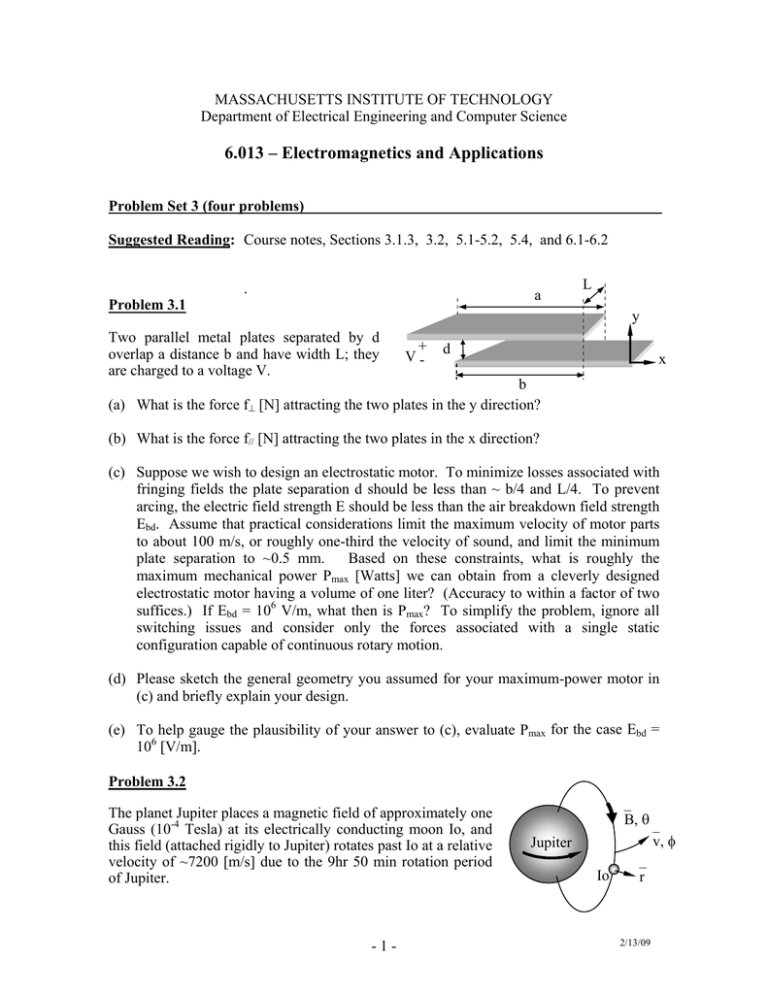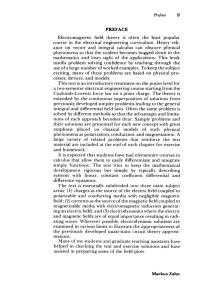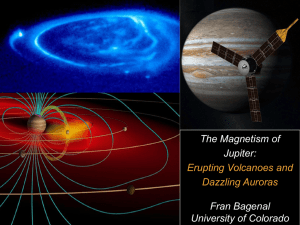Document 13436454
advertisement

MASSACHUSETTS INSTITUTE OF TECHNOLOGY Department of Electrical Engineering and Computer Science 6.013 – Electromagnetics and Applications Problem Set 3 (four problems) Suggested Reading: Course notes, Sections 3.1.3, 3.2, 5.1-5.2, 5.4, and 6.1-6.2 . a Problem 3.1 L y Two parallel metal plates separated by d overlap a distance b and have width L; they are charged to a voltage V. + V- d x b (a) What is the force f⊥ [N] attracting the two plates in the y direction? (b) What is the force f// [N] attracting the two plates in the x direction? (c) Suppose we wish to design an electrostatic motor. T o minimize losses associated with fringing fields the plate separation d should be less than ~ b/4 and L/4. To prevent arcing, the electric field strength E should be less than the air breakdown field strength Ebd. Assume that practical considerations limit the maximum velocity of motor parts to about 100 m/s, or roughly one-third the velocity of sound, and limit the minimum plate separation to ~0.5 mm. Based on these constraints, what is roughly the maximum mechanical power Pmax [Watts] we can obtain from a cleverly designed electrostatic motor having a volume of one liter? (Accuracy to within a factor of two suffices.) If Ebd = 106 V/m, what then is Pmax? To simplify the problem, ignore all switching issues and consider only the forces associated with a single static configuration capable of continuous rotary motion. (d) Please sketch the general geometry you assumed for your maximum-power motor in (c) and briefly explain your design. (e) To help gauge the plausibility of your answer to (c), evaluate Pmax for the case Ebd = 106 [V/m]. Problem 3.2 The planet Jupiter places a magnetic field of approximately one Gauss (10-4 Tesla) at its electrically conducting moon Io, and this field (attached rigidly to Jupiter) rotates past Io at a relative velocity of ~7200 [m/s] due to the 9hr 50 min rotation period of Jupiter. - 1 - ⎯B, θ ⎯v, φ Jupiter Io ⎯r 2/13/09 (a) What is the maximum voltage V (numerical value) induced across the ~3340-km diameter of Io by this moving magnetic field? (b) This voltage produces a current I that flows through a weak plasma along the magnetic field lines down to Jupiter’s ionosphere and back, and then through the full diameter of Io, with a total circuit resistance of about one ohm. What is the resulting magnetic force vector f [N] on Io? Does this force tend to accelerate Io or slow it down in its orbit about Jupiter (Io moves in the same direction Jupiter is rotating)?⎯Explain briefly with a sketch showing the directions of the current through Io and the force on Io. (c) What mechanical power P [W] is being applied to Io (numerical value)? This can be compared to the ~1 GW electrical power typically radiated in radio and television broadcast bands by these Io-generated currents. Problem 3.3 A firm manufacturing devices that accelerate electrons to energies of 106 electron volts ( 1 e.v. equals 1.6 x 10-19 Joules) suggests that its accelerators could attack weapons in space at great distances. If the terrestrial magnetic field B at the altitudes of interest is approximately 10-5 Tesla, what is the maximum range of such a device in vacuum when it is aimed perpendicular to the magnetic field? For simplicity ignore the relativistic increase in electron mass that occurs at 1Mev. Problem 3.4 An solid iron cylinder of permeability μ, length D, and area A is bent in a circle, as illustrated, with a small gap d. N turns of wire carrying I amperes circle the cylinder to yield a magnetic field of Bg within the gap; the gap stores nearly all the energy. Circumference D (a) What is the inductance L of this device? (b) What is the force f pulling the gap closed? (c) What is L when there is no gap? μ I + V - d N A (d) Sketch the approximate vector magnetic field B outside the torus. (e) If the wire is superconducting and the situation is static, the inductor voltage V = 0. If now we mechanically force d → 2d in τ seconds with I held constant, what is V(t) during this period? One could make a sensor this way, perhaps a microphone. - 2 - 2/13/09 MIT OpenCourseWare http://ocw.mit.edu 6.013 Electromagnetics and Applications Spring 2009 For information about citing these materials or our Terms of Use, visit: http://ocw.mit.edu/terms.





